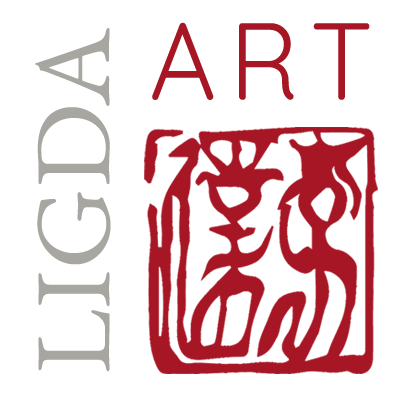Mark-Making - Chinese Influences and Chop Process
John Ligda’s training in Chinese Art and Art History began in Taiwan, 1990-91. There he has found his first mentor, Ms. Liang Dan Fong, one of the most outstanding painters, writers, and educators in Taiwan, as he narrates:
“When in Taiwan, I had the opportunity to learn techniques from the daughter of the court artist to Chiang Kai Shek, called Liang Dan Fong, who became my mentor. A circle of established painters accepted me among them and gave me a Chinese name—Li Da—that remains my artist signature, hand-carved in the chop.”
“Ms. Liang Dan Fong artistic career spans more than 70 years and has held more than 200 solo exhibitions worldwide. Her works have been collected by Museum für Ostasiatische Kunst, Berlin, Museum für Angewandte Kunst, Vienna, Banque Indosuez, Switzerland, St. John’s University, and many others. She has received many awards including the National Award for Arts, the National Medal for Arts, the Century Dragon Award, the Hiromichi Award, the highest cultural award in Taiwan — the National Cultural Award by Ministry of Education, and more than 10 distinguished awards worldwide.”.2
The chop is the mark left from the red tint, the cinnabar, applied with a hand-carved stone insignia.
The insignia carries an intention, designating the work only one person can do. Hence, the mark or name chosen for the artist’s insignia carries their identity. In John’s case, his master chose the two Chinese characters Li Da, which were the phonetic representation of Ligda, his last name, for him to sign his drawings.
After that, the characters “Li Da” were purposefully matched to ancient forms of Chinese, and hand-carved by John in the chop. These ancient forms were found on 4–8-thousand-year-old bronzes and can be found on such dictionaries shown here:
The cinnabar used with the chop is a form of oxidized mercury found in nature, and “occurs in granular crusts or veins associated with volcanic activity and hot springs.”. According to the Metropolitan Museum of Art, “Research shows it has been used at various times and places to denote blood, victory, success, the duality of life and death, and immortality”. In one of its translations, it means “lost dragon blood”.
When John came back to California and picked up “mark-making-figure" drawing in San Francisco as Education in Advanced Figure Drawing5, he relied heavily upon philosophy from the Far East:
“Eastern philosophy has always been an important influence on my work, and when my practice moved into a form of expressive figurative and abstract drawing from 2011 on, it inevitably honored traditional Chinese brushwork.”
References:
The Story of Cinnabar and Vermilion (HgS) at The Met, < https://www.metmuseum.org/blogs/collection-insights/2018/cinnabar-vermilion >.
Photo and short biography of Ms. Lian Ms. Liang Dan Fong <https://ournarratives.net/dan-fong-liang-artist-writer/>.





